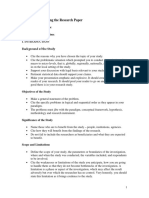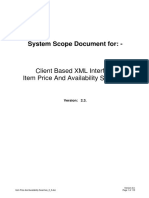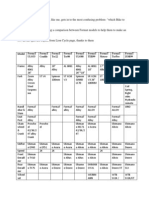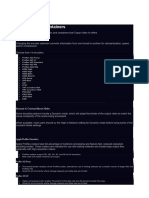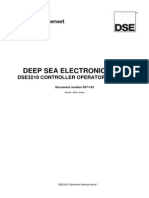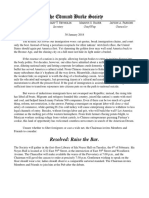Reverse Chronological, Functional & Mixed Resume Formats: Sue Campbell
Reverse Chronological, Functional & Mixed Resume Formats: Sue Campbell
Uploaded by
pathak85Copyright:
Available Formats
Reverse Chronological, Functional & Mixed Resume Formats: Sue Campbell
Reverse Chronological, Functional & Mixed Resume Formats: Sue Campbell
Uploaded by
pathak85Original Description:
Original Title
Copyright
Available Formats
Share this document
Did you find this document useful?
Is this content inappropriate?
Copyright:
Available Formats
Reverse Chronological, Functional & Mixed Resume Formats: Sue Campbell
Reverse Chronological, Functional & Mixed Resume Formats: Sue Campbell
Uploaded by
pathak85Copyright:
Available Formats
Reverse Chronological, Functional & Mixed Resume
Formats
By Sue Campbell, 1st-Writer.com
When writing your resume, which format is better to follow: a reverse chronological format that
lists your most recent positions and responsibilities in priority and in detail, a functional format that
highlights your various areas of expertise without addressing where or when these responsibilities
took place, or a mixed format that attempts to present relevant skills and experience in priority by
presenting this information under the split headings of “Relevant Experience” and “Additional
Employment History?”
For most job candidates, a reverse chronological format is the best choice. It provides the
reader with a logical history of the job candidate's experience and achievements in a format that is
easy to follow and reference. If written well, this format will also take advantage of the job
candidate's areas of expertise and give the reader a full sense of what the job candidate has to
offer.
For others, a functional format may be viewed as the best choice, particularly for those who
have gaps in their employment, are reentering the job force after an extended absence, are
targeting positions that are more in line with positions held in the distant past, or are changing
careers and want to bring skills outside their applied titles to the forefront.
For example, an administrative assistant who wants to apply for marketing positions may choose a
functional format as a way to bring his or her marketing skills to the forefront, while these skills
may be less appreciated or undervalued when placed beneath the title of “Administrative Assistant.”
The problem with using a functional format is that potential employers are quite aware of why this
format is used, and may look at a functional resume with some skepticism, initially, as they try to
ascertain why a candidate chose to use this format.
Another alternative is a mixed format where a job candidate lists positions and responsibilities
most relevant to the targeted position in priority, regardless of their over all chronological order,
and includes a secondary heading of “Additional Employment History” at the end of the document
to address additional, but less relevant, positions held. The problem with this format is that it can
be confusing for the reader, and it can create a sense of gaps in employment where none actually
exist.
When we consider that the resume document is written for the benefit of the reader (potential
employer or hiring manager), and that the average resume only receives an initial “reading” time of
15 seconds or less, any perceived value one may have in choosing a functional or mixed format
may be lost in its actual application. Therefore, the majority of job candidates would be best served
by using a reverse chronological resume. The reverse chronological format remains the format of
choice by both job hunters and hiring managers.
(To see resumes in all the file formats used in an effective job search: word processed, PDF, HTML
and ASCII files, see "Free Resume Examples.")
Reverse Chronological Resume
To bring specific skills or areas of expertise to the forefront, begin your reverse chronological
resume with a strong professional summary section (see Resume Basics and examples of resumes).
A reverse chronological order of employment information begins with the most recent position, and
moves backward in time in a reverse chronological format.
Most employers are only interested in that information which is most current (10-15 years of most
recent experience) and most relevant to the position being targeted. Therefore, it’s only necessary
to go into detail regarding the most recent positions. Older positions can be listed with less detail,
with the knowledge that they can be discussed or addressed at greater length at the interview.
Example:
Most Recent Job Title
Month Year – Present
Company Name, City, State
Responsibility and achievement…
Responsibility and achievement…
Responsibility and achievement…
Next Most Recent Position
Month Year – Month Year
Company Name, City, State
Responsibility and achievement…
Responsibility and achievement…
Responsibility and achievement…
For job candidates who can show progressive growth within a single company, this growth can be
illustrated in the reverse chronological format by beginning with the company name, followed by
individual titles, dates and responsibilities held within the single company, in a reverse chronological
format.
Example:
Company Name, City, State Month Year – Present
Progressively promoted to positions of increased accountability
Most Recent Job Title & Promotion (Month Year - Present)
Responsibility and achievement…
Responsibility and achievement…
Responsibility and achievement…
Next Most Recent Position & Promotion (Month Year - Month Year)
Responsibility and achievement…
Responsibility and achievement…
Responsibility and achievement…
Whichever order of listing you choose (title or company name in priority), keep it consistent
throughout the document.
You can bring skills relevant to the positions you’re targeting to the forefront of your individual job
listings by listing them in priority and by using industry specific language. This is true even when
targeting jobs that are outside your previous titles. For example, if you’re an administrative
assistant wanting to target marketing positions, you can augment your actual title with the area of
expertise you want to target and then list those applicable responsibilities early in your list of
responsibility statements.
Example:
Administrative Assistant - Marketing
Month Year – Month Year
Company Name, City, State
Designed and developed marketing strategies that…
Created a customer newsletter to promote…
Identified potential target markets…and…
Represented company at industry trade shows…
Communicated with existing and potential clients to promote…
Education isn’t always listed in its order of historical occurrence, even in a reverse chronological
resume. Where education is listed is determined by its ability to qualify you for the position you're
targeting. If, for example, your educational achievements are your strongest qualifications for the
position, then the education section would take priority over applied experience. However, if you
have applied experience that is directly relevant and valuable to the position being targeted, even if
your education is your most current achievement, it will usually take priority, as applied experience
almost always holds preferential value.
What does this mean? It means that while your educational achievements may be important, and
may even be a determining factor in your ability to secure the position (a job ad notes, for
example, that a Bachelor of Science degree is required for consideration), a potential employer will
likely be more interested in what you've done and where you’ve applied your skills in the past, and
how your efforts and contributions impacted previous employers.
Consider, for example, that it’s extremely important for you to know that your dentist has the
credentials and educational requirements necessary to practice dentistry, but that you may be more
comforted to know that he or she has performed a specific procedure (successfully and with
excellent results) many times in the past. Relevant past experience is the greatest indicator of
future performance.
If you have little or no applied experience in your targeted industry, then educational achievements
can and should take priority in the document. (See New Graduate.)
The basic order of information in a reverse chronological resume:
Name
Contact Information
Objective Statement (optional)
Summary of Qualifications
Professional Experience
Educational Achievements
Relevant Professional Associations (optional)
Functional Resume
A functional resume attempts to bring relevant skills and experience to the forefront of the resume
document, with no explanation regarding where and when these skills and responsibilities took
place.
Typical headings in a functional resume can include: Sales; Management; Project Leadership,
Marketing; etc., with priority given to those headings that are most relevant to the position being
targeted.
Following the functional headings, an employment history follows, but with little or no detail.
Example:
MANAGEMENT
Management skill, responsibility and/or achievement…
Management skill, responsibility and/or achievement…
Management skill, responsibility and/or achievement…
SALES & MARKETING
Sales and marketing skills, responsibilities and/or achievements…
Sales and marketing skills, responsibilities and/or achievements…
Sales and marketing skills, responsibilities and/or achievements…
PROJECT LEADERSHIP
Project leadership: responsibility and/or achievement…
Project leadership: responsibility and/or achievement…
Project leadership: responsibility and/or achievement…
EMPLOYMENT HISTORY
Month Year – Month Year
Name of Company, City, State
Month Year – Month Year
Name of Company, City, State
Month Year – Month Year
Name of Company, City, State
Month Year – Month Year
Name of Company, City, State
Within the functional headings above, the responsibilities and achievements listed could have taken
place this year or ten years ago. It will be up to the interviewer to determine where and when
these responsibilities took place.
The basic order of information in a functional resume:
Name
Contact Information
Objective Statement (optional)
Functional Headings (Marketing, Management, Project Leadership, etc.) in order of their value and
relevance to the positions being targeted
Employment History (in reverse chronological format, with little or no detail)
Education
Relevant Professional Associations (optional)
Mixed Resume
A mixed resume attempts to bring more relevant history to the forefront by breaking the
employment history in to two sections: “Relevant Career Background” and “Additional Employment
History.” Each section follows a reverse chronological format, but with the relevant section of
information taking priority. The first position listed under the "Relevant Career Background" may or
may not be the candidate's current or most recent position.
Example:
RELEVANT CAREER BACKGROUND
Most Recent Relevant Position
Month Year – Month Year
Company Name, City, State
Responsibility and achievement…
Responsibility and achievement…
Responsibility and achievement…
Next Most Relevant Position
Month Year – Month Year
Company Name, City, State
Responsibility and achievement…
Responsibility and achievement…
Responsibility and achievement…
EDUCATION (listed in priority if it's more relevant to the targeted positions)
University Name, City, State Year
Degree
Year
University Name, City, State
Degree
ADDITIONAL EMPLOYMENT HISTORY
Position Title
Month Year – Present
Company Name, City, State
Responsibility and achievement…
Next Position Title
Month Year – Month Year
Company Name, City, State
Responsibility and achievement…
The basic order of information in a mixed format resume:
Name
Contact Information
Objective Statement (optional)
Summary of Qualifications
Relevant Career Background (beginning with the most recent relevant position)
Education (the priority given this section is determined by its qualification value)
Relevant Professional Associations (optional)
Additional Employment History (in reverse chronological format)
You might also like
- Semi Detailed Lesson Plan (Nature and Concept of Management)Document2 pagesSemi Detailed Lesson Plan (Nature and Concept of Management)jeline100% (3)
- Sony DSC-f828 Camera Service ManualDocument76 pagesSony DSC-f828 Camera Service ManualgchafeeNo ratings yet
- Class 5 Casestudy LucentDocument3 pagesClass 5 Casestudy LucentDoreen WangNo ratings yet
- Resume Format: The Purpose of ResumesDocument2 pagesResume Format: The Purpose of ResumesKharade Rajendra100% (1)
- FormatDocument4 pagesFormatDe Villa GioNo ratings yet
- Step by Step Format String Exploitation On WindowsDocument20 pagesStep by Step Format String Exploitation On Windowsargie100% (1)
- File FormatDocument11 pagesFile FormatAnya AshuNo ratings yet
- Mission Report FormatDocument2 pagesMission Report FormatLaurentiu Ciobanu100% (2)
- FormatDocument17 pagesFormatgskn4u7183No ratings yet
- Action Message FormatDocument4 pagesAction Message FormatsuperboumNo ratings yet
- Item Price and Availability Searches - 2 - 3Document113 pagesItem Price and Availability Searches - 2 - 3べ とNo ratings yet
- Format ModelsDocument2 pagesFormat ModelsAlmaji KishoreNo ratings yet
- Pradhan Mantri Gram Sadak Yojana (Pmgsy) Summary Sheet: Annexure-7.1 Format F-1 (See para 7.2Document10 pagesPradhan Mantri Gram Sadak Yojana (Pmgsy) Summary Sheet: Annexure-7.1 Format F-1 (See para 7.2TarunNo ratings yet
- DHHS Information Asset Register Extract 11 Jan 2018Document260 pagesDHHS Information Asset Register Extract 11 Jan 2018Wadi Ouallen100% (1)
- Application Format: HOUSE NO. 1187 Sector 43, Gurgaon Haryana Pin: 122 015Document4 pagesApplication Format: HOUSE NO. 1187 Sector 43, Gurgaon Haryana Pin: 122 015ggnNo ratings yet
- Case Study On YahooDocument6 pagesCase Study On Yahooarvind_baliyanNo ratings yet
- Tata Institute of Social Sciences: Tiss National Entrance Test (Tissnet)Document5 pagesTata Institute of Social Sciences: Tiss National Entrance Test (Tissnet)Tushar RoyNo ratings yet
- Format Model ModifiersDocument4 pagesFormat Model ModifiersFrancesHsiehNo ratings yet
- Date Format 91f2ebaDocument4 pagesDate Format 91f2ebazzgNo ratings yet
- Android Application Locates Facebook Friends On A Google MapDocument33 pagesAndroid Application Locates Facebook Friends On A Google MapPravin MuliyashiyaNo ratings yet
- Dice Energy Report FormatDocument2 pagesDice Energy Report Formatdani2611No ratings yet
- Facebook: Facebook Is An American Online Social Media andDocument69 pagesFacebook: Facebook Is An American Online Social Media andTabata SantanaNo ratings yet
- Proceeding FormatDocument1 pageProceeding FormatAlshargabi MusaabNo ratings yet
- Add Link To Facebook PluginDocument12 pagesAdd Link To Facebook PluginsmartbzsNo ratings yet
- Savin 2404WD Wide FormatDocument6 pagesSavin 2404WD Wide FormatJAGADEESHNo ratings yet
- METROLAND - Billing FormatDocument3 pagesMETROLAND - Billing FormatVer Development Corp.No ratings yet
- The Text With KeywordsDocument3 pagesThe Text With KeywordsdarviusNo ratings yet
- Wide Format Dealer Service Training - Student Handbook PDFDocument7 pagesWide Format Dealer Service Training - Student Handbook PDFpaulo michaelNo ratings yet
- Issue Billing Document Output in XML FormatDocument6 pagesIssue Billing Document Output in XML FormatMADHU sudhanNo ratings yet
- Easy ListDocument1,342 pagesEasy ListRahasia_NegaraNo ratings yet
- Billing DataDocument210 pagesBilling Datakrishnacfp2320% (1)
- Real Estate in SrsDocument12 pagesReal Estate in Srsfyp 2019No ratings yet
- Apa FormatDocument26 pagesApa FormatBimboy CuenoNo ratings yet
- VideoFormat 2023 10Document4 pagesVideoFormat 2023 10Alex M.No ratings yet
- Journey To Egypt Theme Overview and HandoutsDocument13 pagesJourney To Egypt Theme Overview and HandoutsPastor JeanneNo ratings yet
- Dating LPS: Music Reference Services QuarterlyDocument10 pagesDating LPS: Music Reference Services QuarterlyAndreia DuarteNo ratings yet
- Model FormatDocument175 pagesModel Formatjain93kunalNo ratings yet
- Yahoo Managing An Online BrandDocument25 pagesYahoo Managing An Online BrandtutingNo ratings yet
- Documents - Explore & Upload For Free - ScribdDocument11 pagesDocuments - Explore & Upload For Free - ScribdTuck James ManagementNo ratings yet
- New House Rent Bill 2010Document11 pagesNew House Rent Bill 2010Mubarak Ali SraaNo ratings yet
- Progress BillingDocument2 pagesProgress BillingrpillzNo ratings yet
- Yahoo Web ServiceDocument5 pagesYahoo Web ServicehappyfeetiamNo ratings yet
- Format TrigDocument5 pagesFormat TrigsujaypalleNo ratings yet
- What Is Inheritance ?Document4 pagesWhat Is Inheritance ?ultrasamsNo ratings yet
- Carrier Billing (DOB)Document34 pagesCarrier Billing (DOB)Mahmoud Abu-GhaliNo ratings yet
- Technofab Engineering Limited: Remburshment of Cell Phone ExpancesDocument1 pageTechnofab Engineering Limited: Remburshment of Cell Phone Expancessatenderrose50% (2)
- UnemploymentDocument4 pagesUnemploymentArthas LaveentineNo ratings yet
- APA FormatDocument35 pagesAPA FormatJam CA ☆No ratings yet
- Internet Crime and Anti Fraud Activism - A Hands On ApproachDocument16 pagesInternet Crime and Anti Fraud Activism - A Hands On ApproachBullion TradingNo ratings yet
- Apartment Hotel ClassificationDocument20 pagesApartment Hotel ClassificationRajiv RanajnNo ratings yet
- 14 Multicash FormatDocument4 pages14 Multicash FormatPavan KumarNo ratings yet
- Section 2Document2 pagesSection 2IULIA GYONGYI LUTARUNo ratings yet
- House Hearing, 110TH Congress - Yellowstone National Park BisonDocument79 pagesHouse Hearing, 110TH Congress - Yellowstone National Park BisonScribd Government DocsNo ratings yet
- Best Three DatingDocument5 pagesBest Three Datingsasakrst100% (1)
- Believe in or Believe OnDocument4 pagesBelieve in or Believe Onapi-3830267No ratings yet
- Micro Eros Te/Tm DR List (225 Drs / Te/Tm/Bdm)Document43 pagesMicro Eros Te/Tm DR List (225 Drs / Te/Tm/Bdm)Poornima PaiNo ratings yet
- Dating FormatDocument2 pagesDating FormatAfield FingerprintNo ratings yet
- Apa FormatDocument16 pagesApa FormatWalidTranscendentalist100% (1)
- 2019 ELT Oxford University Germany and Australia CatalogueDocument9 pages2019 ELT Oxford University Germany and Australia CatalogueJuan Jose AvilaNo ratings yet
- Dse3210 ManualDocument32 pagesDse3210 Manualabuzer1981No ratings yet
- Edmund Burke Maroon 2/4/18Document1 pageEdmund Burke Maroon 2/4/18Chicago MaroonNo ratings yet
- Meter, PD Model T-40: Form No. P0567.06Document4 pagesMeter, PD Model T-40: Form No. P0567.06qaramanNo ratings yet
- WSH Performance (2019) - Coca-ColaDocument13 pagesWSH Performance (2019) - Coca-ColaAUNG AUNG ZAWNo ratings yet
- Civil EngineerDocument18 pagesCivil EngineerNazmus SakibNo ratings yet
- Skip Tracing ToolDocument16 pagesSkip Tracing ToolNizah MarieNo ratings yet
- Interviews QuestionsDocument2 pagesInterviews QuestionsBilal AhmadNo ratings yet
- Trends in Offensive Team Activity in BasketballDocument8 pagesTrends in Offensive Team Activity in BasketballCoach-NeilKhayechNo ratings yet
- Macro and Micro Elements in PlantsDocument2 pagesMacro and Micro Elements in PlantsAngelicaMarieValeroBontales0% (1)
- BSC Information Technology Full Project WorkDocument66 pagesBSC Information Technology Full Project WorkzainkennyodutayoNo ratings yet
- 41 Essential SQL Interview Questions and Answers - Toptal®Document26 pages41 Essential SQL Interview Questions and Answers - Toptal®kunche gangadhara raoNo ratings yet
- ActrosDocument100 pagesActrosrudi94% (16)
- BCG Matrix of Itc LTDDocument27 pagesBCG Matrix of Itc LTDNeha LodayaNo ratings yet
- Example and Exercise News ItemDocument5 pagesExample and Exercise News ItemSevira FerdinanNo ratings yet
- AISC - Inspection of Welded and Bolted JointsDocument26 pagesAISC - Inspection of Welded and Bolted JointsAdisak AumpiemNo ratings yet
- Directory of Officers / Faculty & Employees of NIFT Campus / Ho Designation Name E-Mail Office Telephone No.080 22552565Document39 pagesDirectory of Officers / Faculty & Employees of NIFT Campus / Ho Designation Name E-Mail Office Telephone No.080 22552565avinash purtyNo ratings yet
- 8 - Chapter - INVESTMENT PROPERTYDocument49 pages8 - Chapter - INVESTMENT PROPERTYchingNo ratings yet
- Mid187 Ppid1411 Se5501Document1 pageMid187 Ppid1411 Se5501AwanNo ratings yet
- FortiGate PPTP VPN User Guide Version 3.0 MR5Document32 pagesFortiGate PPTP VPN User Guide Version 3.0 MR5Kim Chua LeeNo ratings yet
- Building Innovation Superclusters Report - 2019 1 PDFDocument58 pagesBuilding Innovation Superclusters Report - 2019 1 PDFSheila English100% (1)
- Study Material: Downloaded From VedantuDocument23 pagesStudy Material: Downloaded From VedantuAJEET VIMALNo ratings yet
- Soft X-Ray Optics (Eberhard - Spiller)Document291 pagesSoft X-Ray Optics (Eberhard - Spiller)utente489133No ratings yet
- Knapsack LectDocument17 pagesKnapsack Lectazeemahmad570No ratings yet
- ML at Icl Reinforcement Learning: in A NutshellDocument60 pagesML at Icl Reinforcement Learning: in A Nutshellpavancreative81No ratings yet
- Mortara - Electro.350 Service ManualDocument89 pagesMortara - Electro.350 Service Manualdouglas rinconNo ratings yet
- Plato and AristotleDocument7 pagesPlato and AristotleMunish AlaghNo ratings yet




